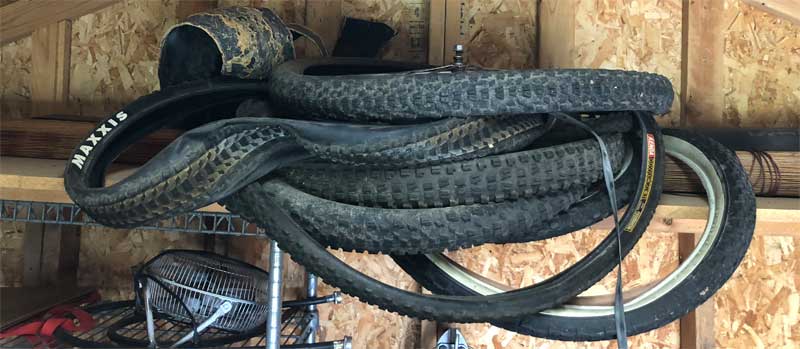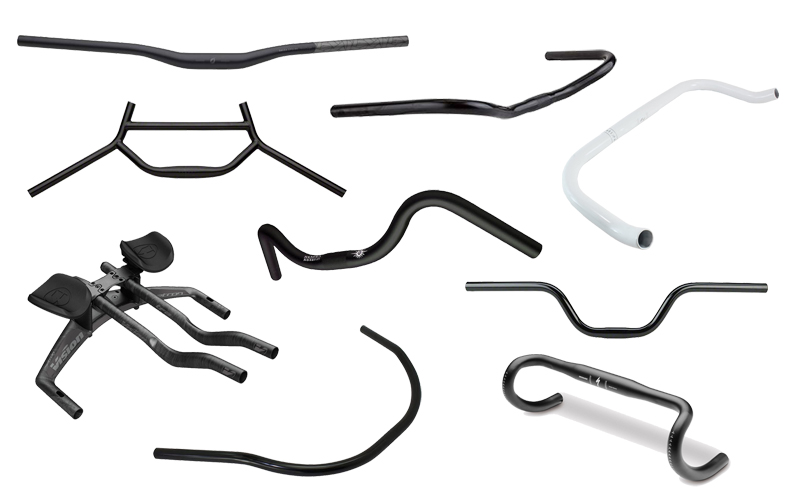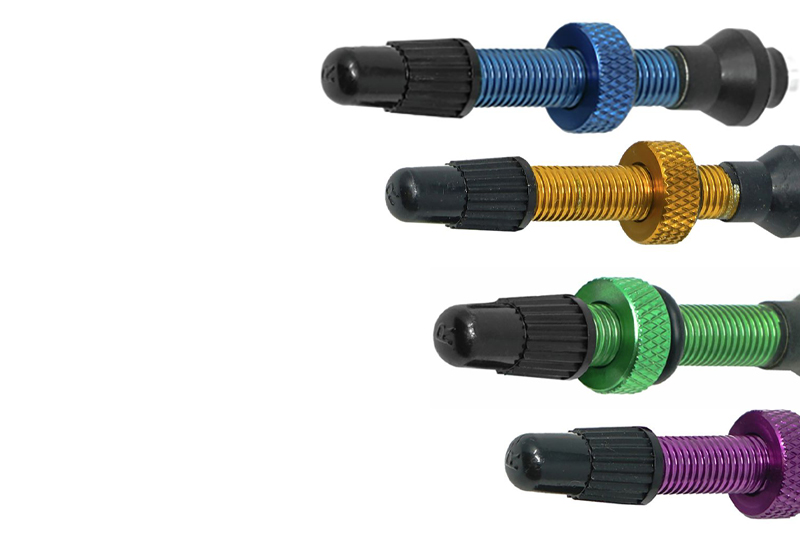How to Store Bike Tires: 5 Essential Tips
Using the quick and easy principles in this article, we can help you learn how to store your bike tires for the season.
Most of us don’t live in an area where we can cycle all year round. Inevitably, this means there comes a time when our bikes are forced to retire for a season or two.
This typically involves tossing them in a garage, basement, or attic, not to be thought of again until the days grow sunnier, warmer, and longer.
But, did you know that improperly storing your bike can damage its expensive tires? The good news is that with the help of professionals, we’ve made it super easy to ensure you’re ready to roll when the time comes.
Let’s start with an obvious question:
Why Worry About How to Store Bike Tires?
Modern bike tires are made from a combination of ingredients like natural and synthetic rubbers, fillers like carbon black, and softeners such as silica and waxes.
Related: A Step-by-Step Exploration of the Bike Tire Manufacturing Process
As its rubber flexes and compresses during regular use, these waxes and other beneficial ingredients are distributed evenly, also making their way to the surface. This helps keep the tire pliable and ride-worthy.
The Four Main Causes of Tire Degradation
However, when a bike tire sits idle and these ingredients aren’t distributed, the rubber slowly oxidizes and begins breaking down at the molecular level. As a result, it becomes stiff, brittle, and cracked—a condition known as ‘dry rot.’
But, disuse isn’t the only gremlin that can eat away at your bike tire investment. Other factors that can cause rubber to prematurely break down include:
- Ultraviolet radiation – Exposure to UV, whether from leaving tires outside throughout a season or even in a garage with windows that receive direct sunlight, can damage its structural integrity.
- Temperature extremes – Rubber is one of the few materials that actually expand when it gets cold, and the constant expansion and contraction caused by temperature swings can be detrimental to its structure.
- Ozone exposure – Compared to normal oxygen (O2), ozone (O3) is an unstable, toxic gas that prematurely breaks down rubber. It’s generated from a variety of sources, including electrical discharges (motors, furnaces, switches, sump pumps, etc.) and UV radiation.
The solution to avoiding damage from all of these sources? Proper storage.
And according to David Albertson, owner of Nice Bike in Denver, Colorado, there’s really not much you can do to screw it up—as long as you follow a few basic tenets. Let’s take a look at them one by one.

#1: How to Prepare Bike Tires for Storage
Start by cleaning your tires of any dirt, grime, or gravel that’s stuck in the tread. Some manufacturers like Continental recommend using a combination of water, soap, and a tire brush to accomplish this. Others, such as Michelin, indicate that water alone is adequate.
Either way, carefully inspect them for excess wear, cracking, or other signs of damage while cleaning. Then, make sure your tires are completely dry.
Note: A popular method used to store car tires is to wrap each one in an airtight plastic bag, such as a lawn or leaf bag, and then close it tightly with tape. Not only does this block UV penetration, but it also helps reduce the evaporation of beneficial waxes and oils.
However, Brett (no last name provided) from Campus Cycles, another popular bike shop in Denver, emphasized that the rubber compounds used in modern bike tires break down very slowly, so this approach might be overkill.
As an example of this, he explained that it’s not uncommon for new tires to remain on shelves for three to four months before being sold, without causing any damage whatsoever.
#2: The Best Places to Store Your Bike Tires
Most professionals like David and Brett, as well as bike tire manufacturers themselves, recommend the same generally ideal storage conditions: No light, low humidity, and in a place that’s not susceptible to extreme heat or cold.
In other words, if you have the available space, suggestions include in an indoor closet, cabinet, or drawer, or even under a bed. Garages and attics are always options, of course, but depending on the climate in which you live, these locations could subject your tires to potentially problematic temperatures.
Also, if there are any windows or vents in these areas, you could unwittingly expose them to UV rays as well.
Another popular option (again, depending on where you live) is storing tires in a basement, which can solve the temperature fluctuation issue. In this scenario, make sure you keep them away from ozone-emitting devices like electric motors and generators, furnaces, switches, sump pumps, and even hot pipes.
Pro tip: If you have no choice but to store your tires outside, Michelin recommends only doing so for a short time, raising them off the ground, and using a “waterproof covering with holes to prevent moisture build-up.”
#3: The Best Methods For Storing Your Bike Tires
To reiterate, both David and Brett emphasize that rubber compounds used in modern bike tires are extraordinarily durable and resistant to breakdown.
This means, outside of leaving them in the elements, or sitting in oil, grease, gasoline, solvents, oils, or grimy deposits in your garage or basement, there’s not a whole you can do to cause meaningful damage.
Still, even among professionals, there are different schools of thought about precisely the best way to go about storing them for a season (or longer).
Stacking Bike Tires
For example, Brett points out that laying bike tires flat on their side and separating them with pieces of cardboard is acceptable. However, it’s not necessarily the first choice, since this can increase stress and cause distortion if left in the same position for months.
David adds that this method can also take up a lot of space.
Hanging Bike Tires
Instead, both Brett and David recommend hanging all of your bike tires on the rim and slightly inflated (a couple of bars of pressure is fine), both of which will help eliminate stress and maintain their shape.
Related: How to Buy a Bike Pump That Meets Your Needs
To accomplish this, anything can work: a garden hose hanger, ladder or lumber hook, j-hook, a 2 x 4 screwed to a stud, or even an oversized nail, screw, or stretched-out bungee cord.
What about if your tires are unmounted? Whether wire or fiber bead, Brett tells us it’s OK to hang your tires by themselves for a season.
On the other hand, David emphasizes that storing folding tires on a hook will tend to droop, distort, and crease it. As a result, he recommends re-folding.
Re-Folding Tires
If you own a tire with a fiber bead, you almost certainly had to unfold it before mounting it to a rim.
As a result, most professionals indicate that re-folding your tires at the end of a season is perfectly acceptable. Simply wrap a rubber band or zip tie around them afterward, and then toss them in a drawer, cabinet, closet, or even in a Rubbermaid container under your bed.
However, Brett points out that like a piece of paper, folding a tire leads to added structural breakdown at the fold, which will cause the rubber to weaken over time. As such, this might not be ideal if you’re planning to store your tires for a lengthy period.
#4: Should You Add a Protectant Before Storing Your Bike Tires?
Writing for VeloNews, Lennard Zinn, legendary author of Zinn and the Art of Bike Maintenance, explains that he applies 303 Protectant before hanging his bike tires on rims, or stacking them flat and unmounted.
However, manufacturers like Michelin specifically indicate that customers shouldn’t use any chemicals when cleaning or storing their tires.
David and Brett told us they’ve never used a similar product, although—again—they didn’t think it would deliver a whole lot of value if you’re only storing your tires for a few months since modern rubber compounds are so durable.
#5: What to Do When Taking Your Bike Tires Out of Storage
While they’re in storage, Continental recommends briefly rolling your tires once per week, if you have space and availability. This can help distribute the waxes, oils, and other beneficial substances mentioned above.
Outside of this, David tells us that when you’re ready to roll again, it’s super simple. Just check your tires for cracking or bulging, and make sure that they still spin straight on the rim after airing them up.
Bottom Line: How Long Will Your Bike Tires Last in Storage?
How long your bike tires will last in storage depends on a variety of variables, include their age, how many miles you’ve put on them, their specific rubber compound, the location where they’re kept, and how closely you follow the recommendations above.
But, as long as you keep them in a dark, dry place with a reasonably constant temperature, Wolf Vormwalde, Tire Product Manager at Specialized Bicycle, who was interviewed for the VeloNews article cited earlier, points out their models are “safe to use for up to six years after manufacturing.”
Keep rolling: How Bike Tires Work: Your Quick-Reference Visual Guide





Abhishek Sa
Well I stored vittoria rubino pro Graphene 2.0 for about an year and the last thing happened is a blast, it was stored like it was boxed, but it was totally closed in a box. I am scared of storing again.